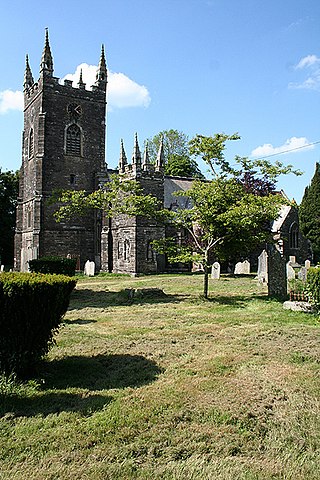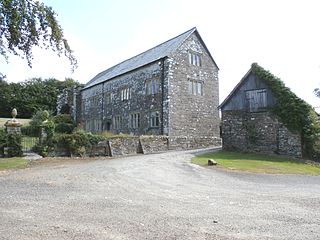
St Erme is a civil parish and village in Cornwall, in the United Kingdom. The parish of St Erme, has a population of approximately 1200. This had increased to 1,363 in 2011 Trispen is a small village within the parish.

Werrington is a civil parish and former manor now in Cornwall, England, United Kingdom. Prior to boundary changes it straddled the Tamar and lay within the county of Devon. The portion on the west side was transferred to Cornwall by the abolition of Broadwoodwidger Rural District by the Local Government Commission for England in 1966. It is situated 1 mile (1.6 km) to the west of the Tamar, the traditional boundary between Devon and Cornwall, and 1 mile (1.6 km) north of Launceston.

Lezant is a civil parish and village in east Cornwall, England, United Kingdom. Lezant village is about five miles south of Launceston. The population of the parish in the 2001 census was 751, increasing slightly to 765 in the 2011 census.

Sir William Coffin was a courtier at the court of King Henry VIII of England. He was a Gentleman of the Privy Chamber to King Henry VIII and Master of the Horse to Queen Jane Seymour. He was elected MP for Derbyshire in 1529.

Portledge Manor is an English manor house in the parish of Alwington, southwest of Bideford, Devon. It and the land surrounding it belonged to the Coffin family, a noble family of Norman origin, for almost 1000 years.

Josias II Calmady of Langdon, in the parish of Wembury, Devon, was Member of Parliament for Okehampton in the Convention Parliament of 1660.

Monkleigh is a village, parish and former manor in north Devon, England. It is situated 2.5 miles (4.0 km) miles north-west of Great Torrington and 3.5 miles (5.6 km) south-east of Bideford. It forms part of the Monkleigh and Littleham electoral ward. The population at the 2011 census was 1,488.

The Manor of Monkleigh was a mediaeval manor centred on the village of Monkleigh in North Devon, England, situated 2 1/2 miles north-west of Great Torrington and 3 1/2 miles south-east of Bideford.

Joseph Prust (1620–1677) of Annery, in the parish of Monkleigh, Devon, was a royalist military commander during the Civil War. He was a lieutenant colonel.

Richard Coffin (1456–1523), of Alwington and Heanton Punchardon in North Devon, was a Sheriff of Devon.

Sir Peter Prideaux, 3rd Baronet (1626–1705), of Netherton in the parish of Farway, near Honiton, Devon, was an English politician.

George Basset, of Tehidy in the parish of Illogan, near Redruth in Cornwall, was an English politician.
East Hagginton was a historic estate within the manor and parish of Berrynarbor near to the coast of North Devon. It is near to, if not actually encompassing, the site of Watermouth Castle.

Bremridge is a historic estate within the former hundred of South Molton in Devon, England. It is now within the parish of Filleigh but was formerly in that of South Molton. It is situated 8 miles north-west of South Molton. Since the construction of the nearby A361 North Devon Link Road direct access has been cut off from Bremridge to Filleigh and South Molton. The surviving wing of the mansion house built in 1654 is a Grade II* listed building. Bremridge Wood is the site of an Iron Age enclosure or hill fort, the earthwork of which is situated on a hillside forming a promontory above the River Bray. In Bremridge Wood survives a disused tunnel of the former Great Western Railway line between South Molton and Barnstaple, much of the course of which has been used for the A361. The tunnel is 319 yards long and was identified as "Bremridge Tunnel" in the 1889 Ordnance Survey map but as "Castle Hill Tunnel" in subsequent editions.

Bableigh is an historic estate in the parish of Parkham in North Devon, England. It is separated from the village of Parkham by the Bableigh Brook. It was the earliest recorded seat of the Risdon family in Devonshire, from which was descended the Devon historian Tristram Risdon.

Yeo Vale is an historic estate in the parish of Alwington in North Devon, England. The grade II listed mansion house known as Yeo Vale House, situated 1 mile east of Alwington Church and 3 miles south-west of Bideford, incorporating a 15th-century gatehouse, was demolished in 1973, having been abandoned as a residence in 1938 and having fallen into a dilapidated state. it was situated in the valley of the River Yeo, a small river flowing into the River Torridge immediately above Bideford. The barton or farmhouse survives, to which was attached the mansion house, together with various out-buildings and stone walls. A private mediaeval chapel was formerly attached to the mansion house and in the early 18th century was demolished and rebuilt as a folly on a hill about 1/4 mile south of the mansion house. It survives today as a ruin overgrown with trees and ivy.

Milton Abbot is a village, parish, and former manor in Devon, 6 miles (9.7 km) north-west of Tavistock, Devon, and 6 miles (9.7 km) south-east of Launceston, Cornwall.
Collacombe is an historic manor in the parish of Lamerton, Devon, England. The manor house survives as a grade I listed building, known as Collacombe Barton or Collacombe Manor (House).

Thomas Northmore (c.1643-1713) of Cleve in the parish of St Thomas, Exeter, in Devon was a Barrister-at-Law, a Master in Chancery and a Member of Parliament for Okehampton in Devon 1695–1708.

Richard Coffin (1623–1700) of Portledge in the parish of Alwington in North Devon, was lord of the manor of Alwington and served as Sheriff of Devon in 1683.




















